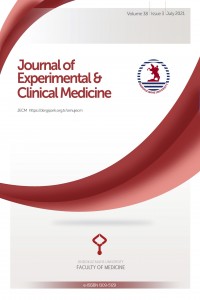Abstract
References
- Cremonesi, P., Di Bella, E., Montefiori, M., Persico, L., 2015. The Robustness and Effectiveness of the Triage System at Times of Overcrowding and the Extra Costs due to Inappropriate Use of Emergency Departments. Appl Health Econ Health Policy, 13:507–14. Doi:10.1007/s40258-015-0166-5.
- Davarci, P. Z., Davarci, I., Sazli, H., 2019. Comparison of AIMS65 and rockall scoring systems for predicting mortality in patients with upper gastrointestinal system hemorrhage. Annals of Medical Research, 26(9):2068-71. Doi: 10.5455/annalsmedres.2019.05.302.
- Kuşcu, Ö.Ö., Elmas, D., Erdoğan, M., Benli, B.A., 2019. Karaoğullarından Ü, İnal MA et al. Retrospective Evaluation of Critical Care Patients with Upper Gastrointestinal System Bleeding. Journal of Medical and Surgical Intensive Care Medicine, 10(3):80.
- Lenzen, H., Musmann, E., Kottas, M., Schönemeier, B., Köhnlein, T., Manns, MP, Lankisch TO., 2017. Acute gastrointestinal bleeding cases presenting to the emergency department are associated with age, sex and seasonal and circadian factors. European journal of gastroenterology and hepatology, 29(1):78-83.Doi: 10.1097/MEG.0000000000000752.
- Prechter, F., Bürger, M., Lehmann, T., Stallmach, A., Schmidt C., 2019. A study on the correlation of gastrointestinal bleeding and meteorological factors–is there a weather condition for GI bleeding? Z Gastroenterol, 57(12): 1476-80. Doi:10.1055/a-1008-9863.
- Uysal, Y., Babus, S.B., Kose, A., Ates, F., Biricik, S., Erdogan, S, Çevik, İ., Toker, İ., Ayrık C., 2019. The prognostic significance of the risk scores at upper gastrointestinal bleeding. Nigerian journal of clinical practice. 22(8):1099-1108.
- Van Leerdam ME., 2008. Epidemiology of acute upper gastrointestinal bleeding. Best practice and research Clinical gastroenterology, 22(2):209-224. Doi: 10.1016/j.bpg.2007.10.011.
- Williams, R.M. The costs of visits to emergency departments. 1996. N Engl J Med, 334(10):642-6. Doi: 10.1056/nejm199603073341007.
- Yalçın, M., Kara, B., Öztürk, NA., Ölmez, Ş., Taşdoğan, BE., Taş, A., 2016. Epidemiology and endoscopic findings of the patients suffering from upper gastrointestinal system bleeding. Dicle Tıp Dergisi, 43(1):73-6. Doi:10.5798/diclemedj.0921.2016.01.0641.
- Zengin, S., Güzel, R., Al, B., Kartal, Ş., Sarcan, E., Yıldırım, C., 2013. Cost Analysis of a University Hospital's Adult Emergency Service. The Journal of Academic Emergency Medicine/Akademik Acil Tip Olgu Sunumlari Dergisi, 12(2):71.
Are AIMS65 and glasgow-blatchford scores useful in predicting health costs in patients admitted to emergency department with acute upper gastrointestinal bleeding: a prospective and observational study
Abstract
Objective
We aimed to investigate the use and superiority of AIMS65 (Albumin, INR, Alteration in mental status, Systolic blood pressure, age) and Glasgow-Blatchford scores in predicting hospital health costs in patients admitted to emergency department with upper gastrointestinal bleeding.
Methods
Patients above the age of 18 who were admitted to the Emergency Department of Umraniye Training and Research Hospital between 01.06.2018 and 31.05.2019, who were diagnosed with upper gastrointestinal bleeding were included in the study. Patients’ calculations of AIMS65 and Glasgow-Blatchford Bleeding scores (GBS) were recorded. Pearson’s Chi-square test was used and statistical significance was assessed.
Results
Out of 151 patients included in the study, 109 (72.2%) were male. Of the patients 2(1.3%) were discharged from the emergency department and 7 (4.6%) were exitus.
According to AIMS65 risk scoring, costs of emergency department and non-emergency clinics and total clinical costs were higher in high risk group compared to the low risk group (p=0.007, p=0.007 and p=0.003 respectively).
The costs of emergency department and non-emergency clinic and total costs were found statistically significantly different between GBS groups (p<0.001, p=0.019, and p=0.001 respectively).
Conclusion
AIMS65 risk score and GBS have been revealed to be useful in predicting the costs of emergency department and non-emergency clinics and total clinical costs for patients with upper gastrointestinal bleeding. However, the usefulness of GBS in predicting possible costs according to risk score of the patient could not be revealed.
References
- Cremonesi, P., Di Bella, E., Montefiori, M., Persico, L., 2015. The Robustness and Effectiveness of the Triage System at Times of Overcrowding and the Extra Costs due to Inappropriate Use of Emergency Departments. Appl Health Econ Health Policy, 13:507–14. Doi:10.1007/s40258-015-0166-5.
- Davarci, P. Z., Davarci, I., Sazli, H., 2019. Comparison of AIMS65 and rockall scoring systems for predicting mortality in patients with upper gastrointestinal system hemorrhage. Annals of Medical Research, 26(9):2068-71. Doi: 10.5455/annalsmedres.2019.05.302.
- Kuşcu, Ö.Ö., Elmas, D., Erdoğan, M., Benli, B.A., 2019. Karaoğullarından Ü, İnal MA et al. Retrospective Evaluation of Critical Care Patients with Upper Gastrointestinal System Bleeding. Journal of Medical and Surgical Intensive Care Medicine, 10(3):80.
- Lenzen, H., Musmann, E., Kottas, M., Schönemeier, B., Köhnlein, T., Manns, MP, Lankisch TO., 2017. Acute gastrointestinal bleeding cases presenting to the emergency department are associated with age, sex and seasonal and circadian factors. European journal of gastroenterology and hepatology, 29(1):78-83.Doi: 10.1097/MEG.0000000000000752.
- Prechter, F., Bürger, M., Lehmann, T., Stallmach, A., Schmidt C., 2019. A study on the correlation of gastrointestinal bleeding and meteorological factors–is there a weather condition for GI bleeding? Z Gastroenterol, 57(12): 1476-80. Doi:10.1055/a-1008-9863.
- Uysal, Y., Babus, S.B., Kose, A., Ates, F., Biricik, S., Erdogan, S, Çevik, İ., Toker, İ., Ayrık C., 2019. The prognostic significance of the risk scores at upper gastrointestinal bleeding. Nigerian journal of clinical practice. 22(8):1099-1108.
- Van Leerdam ME., 2008. Epidemiology of acute upper gastrointestinal bleeding. Best practice and research Clinical gastroenterology, 22(2):209-224. Doi: 10.1016/j.bpg.2007.10.011.
- Williams, R.M. The costs of visits to emergency departments. 1996. N Engl J Med, 334(10):642-6. Doi: 10.1056/nejm199603073341007.
- Yalçın, M., Kara, B., Öztürk, NA., Ölmez, Ş., Taşdoğan, BE., Taş, A., 2016. Epidemiology and endoscopic findings of the patients suffering from upper gastrointestinal system bleeding. Dicle Tıp Dergisi, 43(1):73-6. Doi:10.5798/diclemedj.0921.2016.01.0641.
- Zengin, S., Güzel, R., Al, B., Kartal, Ş., Sarcan, E., Yıldırım, C., 2013. Cost Analysis of a University Hospital's Adult Emergency Service. The Journal of Academic Emergency Medicine/Akademik Acil Tip Olgu Sunumlari Dergisi, 12(2):71.
Details
| Primary Language | English |
|---|---|
| Subjects | Health Care Administration |
| Journal Section | Clinical Research |
| Authors | |
| Publication Date | May 1, 2021 |
| Submission Date | February 4, 2021 |
| Acceptance Date | February 18, 2021 |
| Published in Issue | Year 2021 Volume: 38 Issue: 3 |
Cite

This work is licensed under a Creative Commons Attribution-NonCommercial 4.0 International License.


